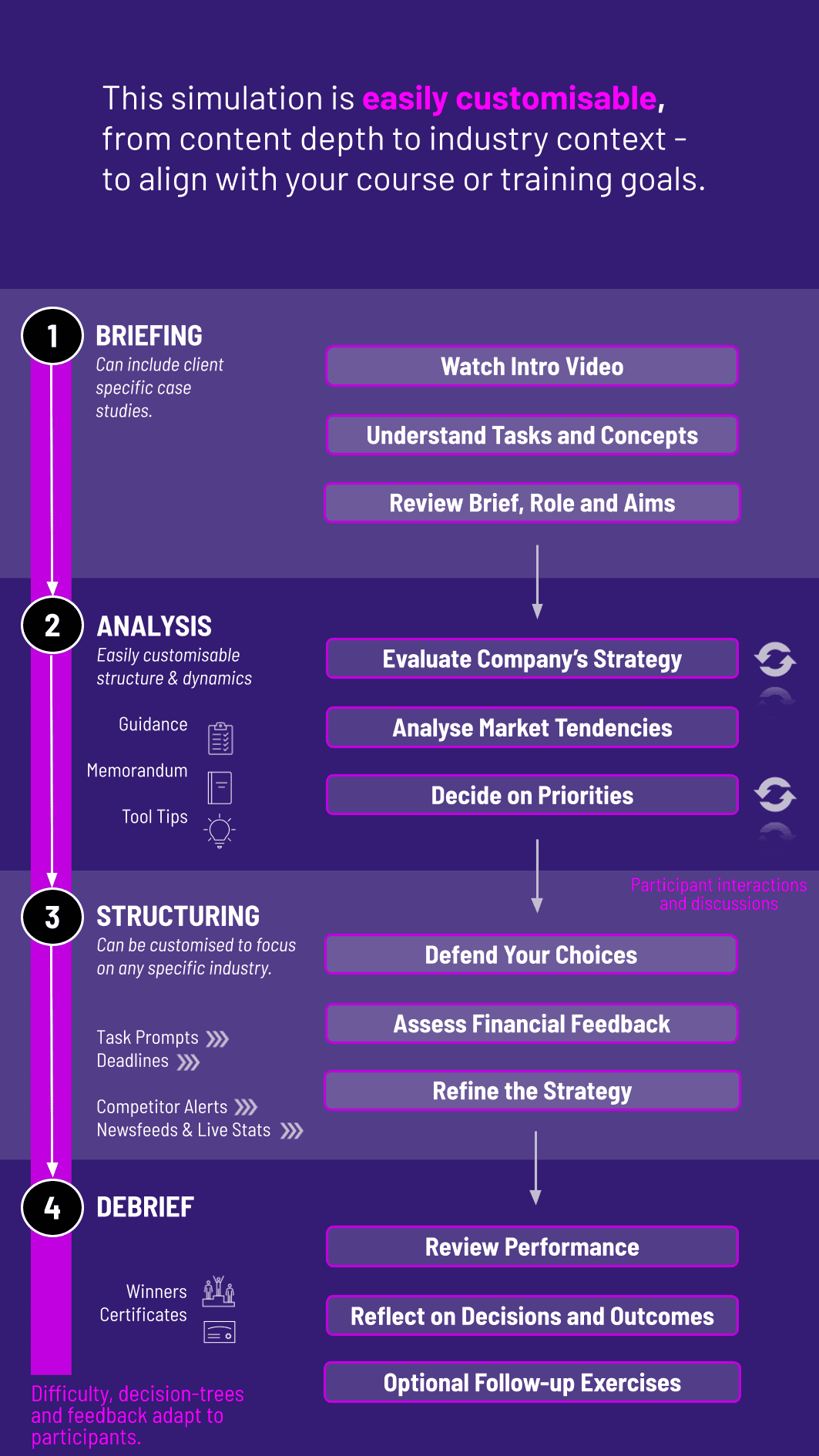
In this simulation, participants act as finance professionals facing dilemmas - balancing profitability, compliance, and integrity while navigating stakeholder pressures, regulatory requirements, and reputational risks under real-world constraints.
Insider trading and market abuse
Conflicts of interest in finance
Mis-selling and client protection
ESG, sustainability, and ethical investment choices
Pressure from earnings targets and performance incentives
Whistleblowing and reporting protocols
Reputational risk and media scrutiny
Ethical frameworks for decision-making
Cultural and global perspectives on finance ethics
Long-term trust vs short-term profit trade-offs


Review case scenarios with competing interests
Debate trade-offs between compliance, profitability, and integrity
Decide on actions under time pressure and uncertainty
Communicate choices to boards, clients, or regulators
Respond to whistleblowers, media coverage, or regulatory audits
Reflect on how their decisions shape trust and credibility
By the end of the simulation, participants will be able to:
Recognize common ethical dilemmas in finance
Apply ethical frameworks to complex decisions
Balance profitability with integrity and compliance
Communicate transparently with stakeholders under pressure
Reflect on the reputational consequences of decisions
Anticipate long-term risks of unethical practices
Manage conflicts of interest responsibly
Foster cultures of transparency and accountability
Understand global perspectives on finance ethics
Strengthen judgment and self-awareness in leadership roles
The simulation’s flexible structure ensures that these objectives can be calibrated to match the depth, duration, and focus areas of each program, whether in higher education or corporate learning.
The simulation can be run individually or in teams, across classrooms or professional programs. Each cycle represents a decision-making round.
1. Receive a Scenario or Brief: Participants are presented with an ethical challenge shaped by financial, regulatory, and reputational factors.
2. Analyse the Situation: They review key details, stakeholder positions, and trade-offs.
3. Make Strategic Decisions: Participants decide whether to prioritize profit, compliance, or ethical considerations.
4. Collaborate Across Roles: Teams role-play as executives, regulators, or clients debating outcomes.
5. Communicate Outcomes: Participants justify choices through board memos, press statements, or client updates.
6. Review and Reflect: Feedback highlights financial impact, reputational outcomes, and stakeholder trust. Participants refine strategies across rounds.
Do participants need finance experience? No. Ethical dilemmas are designed to be relatable for varied audiences.
What roles are included? Bankers, regulators, executives, investors, and clients.
Is this simulation only about compliance? No. It explores ethics beyond compliance, including culture, trust, and responsibility.
Can scenarios be tailored? Yes. They can reflect banking, asset management, fintech, or corporate finance.
How long does it run? It can be delivered in short sessions or extended programs.
Is teamwork part of it? Yes. Group play allows participants to debate ethical trade-offs.
Does it include global perspectives? Yes. Scenarios can explore cultural differences in finance ethics.
Can it be used in executive training? Absolutely. It is highly relevant for leaders balancing profit and integrity.
How is performance measured? By judgment, reasoning, and communication rather than “right answers.”
Can it run online? Yes. It supports hybrid, online, and in-person delivery.
Consistency in applying ethical frameworks
Balance between financial and ethical outcomes
Clarity in communicating rationale
Responsiveness to new information or scrutiny
Collaboration and peer/self-assessment in dilemmas
You can also include memo writing and debrief presentations as part of the assessment structure. Additionally, you can also add a built-in peer and self-assessment tool to see how participants rate themselves. This flexibility allows the simulation to be easily integrated by professors as graded courses at universities and by HR at assessment centres at companies.
Join this 20-minute webinar, followed by a Q&A session, to immerse yourself in the simulation.
or
Book a 15-minute Zoom demo with one of our experts to explore how the simulation can benefit you.